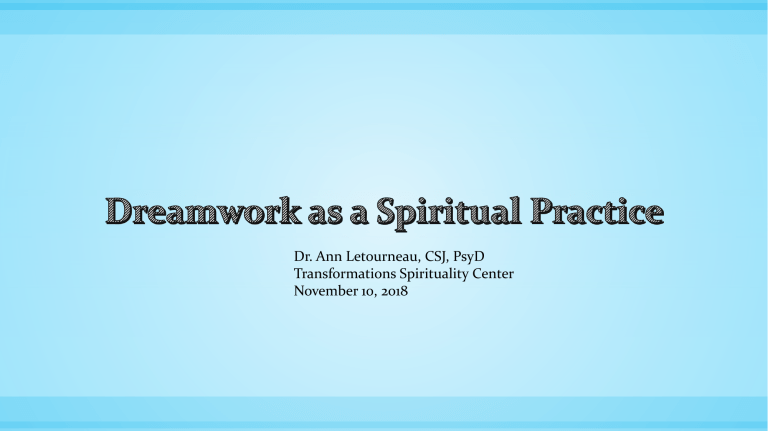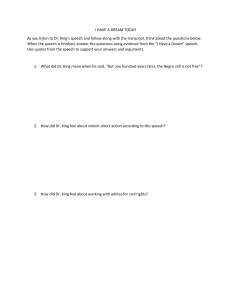
Dr. Ann Letourneau, CSJ, PsyD Transformations Spirituality Center November 10, 2018 I Am Your Dream I am your dream, I swell in your soul in a moment of suspended grace. I am your dream I dance on waters shining in the rising sun. I am your dream— Diamond glinting— in night’s display of stars. I am your dream, I hide in you— burning in your deeps. I am your dream— Your breath of God— waiting to be born. Whispers: Conversations with Edwina Gately by Gately and HammondClark, 2000 What is a spiritual practice? A consistent performance of actions and activities undertaken for the purpose of cultivating spiritual development Which implies The individual wants to be transformed by God The individual takes a stance of openness before God with a listening heart God, through grace, is the source of our transformation. We, in turn, have the choice as to whether or not we want to cooperate with that grace. Spiritual Practice The desires of our deepest selves The deepest desires that God has for us Common Spiritual Practices Dreamwork as a Spiritual Practice An activity undertaken for the purpose of cultivating spiritual development Which implies The individual wants to be transformed by God The individual takes a stance of openness before God “the Dream Maker” with a listening heart God, through grace, is the source of our transformation. We, in turn, have the choice as to whether or not we want to cooperate with that grace. Scripture & Dreams OLD TESTAMENT Genesis 28: 10-22 NEW TESTAMENT Joseph Genesis 40: 1-23 Jesus Abraham, Daniel, & Samuel Matthew, Acts, & the Letters of St. Paul Interruption of the Tradition • Two major turning • Jerome • St. Thomas points: Interruption of the Tradition JEROME • Translated Bible into Latin from Greek and Hebrew manuscripts • Jerome seems to have purposely mistranslated a Hebrew word a number of times in order to include prohibitions against dreamwork in the sacred text • Hebrew word anan means witchcraft o soothsaying; anon was considered a pagan superstitious activity • Jerome translated anon two different ways: “witchcraft” and “observing dreams” thus equating dreamwork equivalent to the pagan activities (347 AD – 420 AD) Interruption of the Tradition ST. THOMAS AQUINAS (1225-1274) • Set out to “modernize” Christianity by integrating Christian theology with Aristotelian thought. • Aristotle taught that human experience was real only if it could be experienced through sensory perception and reason. • Aristotle also believed that dreams had only natural causes so there was no divine significance. • Studied Greek writing Doctors of the early Church who valued dreams and dreamwork. • • St. Thomas adopted Aristotle’s view. This view lasted 7 centuries. Resurgence of Dreams The field of psychology began to bring back the importance of paying attention to dreams beginning with Freud and his student, Jung. John Sanford and Morton Kelsey, both Anglican priests and counselors, are most directly responsible for the rediscovery of the Christian tradition of dreamwork. This is an ongoing development in both the spiritual and psychological fields. Dreamwork SPIRITUAL PSYCHOLOGICAL • Tending to the holy • Tending to personal growth • The intention is to make room for God in our lives • Pay more attention to “troubling” dreams • Bring unconscious to the conscious • God does not factor into this kind of dreamwork • Seeking personal transformation, believing it comes through God’s grace Stages of Sleep Dr. Steve Hackley from the University of Missouri Taken from http://www.endyour-sleepdeprivation.com/stages-ofsleep.html#journey Created by students of Dr. Williams Dement’s Sleep And Dreams course at Stanford University. https://www.youtube.com/watch?v=fNlp0UMqUtM&t=8s DREAM RESEARCH • All people dream • Dreams help us to keep an interior balance • People MUST dream for their psychological, physical, and emotional health; people who are consistently prevented from dreaming get ill • Typically we dream 4 to 7 times per night • It is believed that our last dreaming period of the night is the most important and hold the wisdom of the other dreams John Sanford Jungian Analyst and Episcopal Priest (1921-2005) • Describes dream language as an “as if” language – much like Jesus used in the parables • Our dreams rarely if every can be taken literally • The unconscious part of ourselves holds information that our conscious part does not yet know or remember; we all forget, deny, and repress • Dreams take images we know and communicate something we do not know on a conscious level • Though we are not aware of it, our subconscious impacts much of our thought, feelings, and behaviors. • The more we can bring our unconscious to the conscious the closer we can lint into the full potential that God gave us Carl Jung Swiss Psychiatrist and Psychologist (1875-1961) PERSONAL UNCONSCIOUS COLLECTIVE UNCONSCIOUS What I hold in the unconscious part of myself: The part of our psyche that holds the shared experience of humanity “Everything which I am not at the moment thinking; everything of which I have forgotten; everything perceived by mu senses, but not noted by my conscious mind; everything which involuntarily and without paying attention to it, I feel, think, remember, want and do; all the future things which are taking shape in me and will sometime come to consciousness.” Jung believed that like our bodies have a common structure so do out psyches The common structures are referred to as “archetypes” Keep in Mind • Dreams speak to us in symbols. Very few dreams can be interpreted literally. • The significance of the symbols are rooted in our personal and collective unconscious. • Only the dreamer can say what a symbol means for him/her. • Typically every dream is about the dreamer. Though familiar people and places appear in your dream, it is not usually about that person/place. • Dreams always bring us to health and wholeness. • Some dreams hold more significance than others. • Dreams have layers of meaning and significance. • Dreams come to tell us something we do not already know. Give your Dream a Title • If your dream were a movie, what would it’s title be? • Go with the first thought method • It makes it more memorable/reference-able • Frequently it gives an indication of the core of the message in the dream Association Approach to Dreamwork 1. Writing the Dream (Include Date and Waking Context) 2. Making Associations 3. Connecting with the Dynamics 4. Interpreting the Dream 5. Ritualizing the Dream Step 1: Writing the Dream • Writing a dream out is a way of communicating to the subconscious that we are interested in listening to it and learning from it. • The dream needs to be written in the present, as if it were happening right now. In my dream, I am driving a red car. NOT: In my dream, I was driving a car. Step 2: Making Associations • • • Make a list of each symbol in your dream (people, places, colors, numbers, etc.) Go back to each symbol and write down associations (word, idea, mental picture, feeling, memory, colloquialism, etc.) There is no fool proof method to know when you have come to the meaning of a symbol. It is more of an “aha” or gut feeling. If there is not such connection move to the next symbol. 1. I – typically we are ourselves 2. Driving- in control, way of getting somewhere, freedom, movement 3. Red – intense, vital, animated red light means stop, little red riding hood 4. Car – transportation; freedom; independence; Steps 3 & 4 3. CONNECTING WITH THE DYNAMICS • Sometimes this happens as you are doing Step 2. • Connect the dream images and the associations that came in Step 2 to the inner dynamics of your life. • Example: Red – If I have an aha around “intensity” I might ask, Where am I feeling intensity? What in my life is intense? 4. INTERPRETING THE DREAM • Go back through the symbols to see what message they have as you put them altogether. • Remember: All dreams lead us to health and wholeness. • Avoid any interpretation that shifts responsibility away from yourself. Step 5: Ritualizing the Dream • Think about how your dream is calling you to change your behavior or what it is telling you that you do not already know. • All of the steps up to this point have engaged the mind. This step is really about engaging the physical. • This is key to integrating the dream and the message that it holds into your conscious self. Keep it simple, solitary, and silent. • Example: If your dream is saying that your life needs some organization. You can ritualize this message by cleaning out one drawer. • If you can’t think of something that specifically goes with the theme of the dream, honor the dream by doing something very consciously, like consciously eating an apple with the attitude and awareness that the action is being done specifically to honor the dream. • Ritualizing helps us to move our dream experiences to the emotional and gut level. Working a Dream


